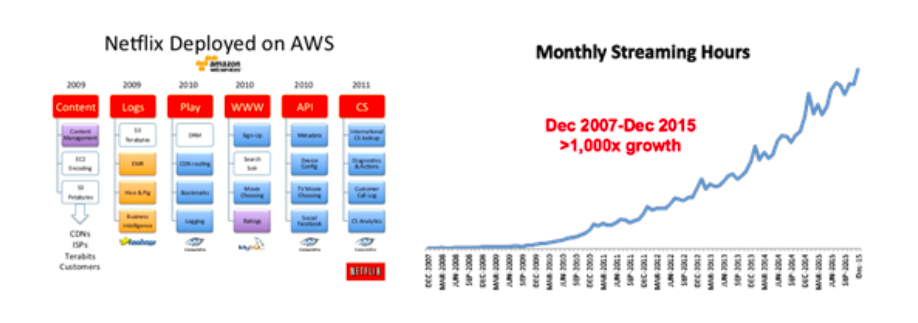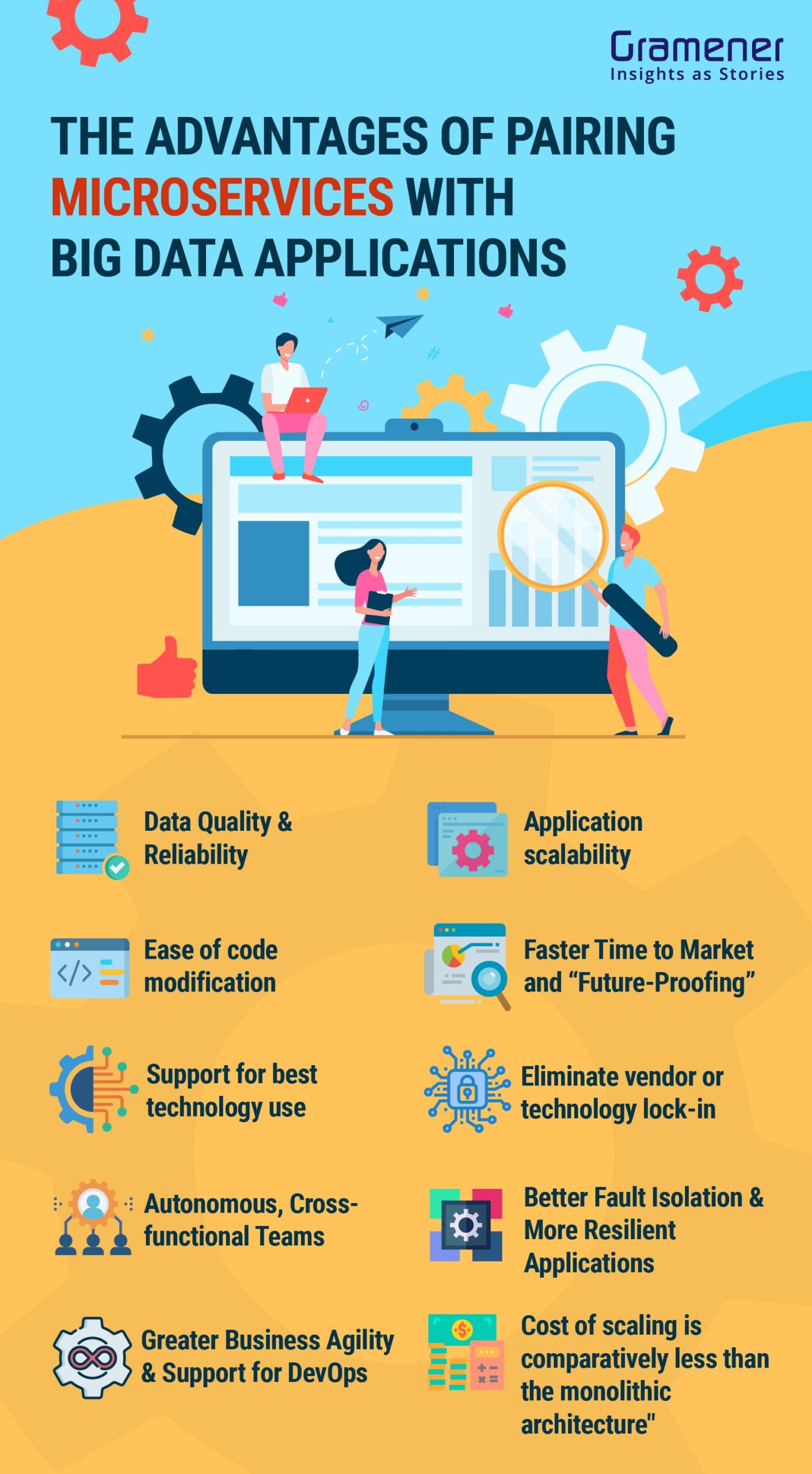We all are familiar with Netflix, Amazon, Uber, Etsy, and many more such brands. Today these brands have become part-and-parcel of our life. But do you know how these enterprises could scale, improve business agility, and boost their profit margins? One of the most significant factors is their timely shift from monolithic applications to microservices-based architectures and applications to handle the big data.
Table of Contents
How Netflix Used the Power of Microservices
Let’s dig a bit deeper, taking the example of Netflix.
In 2007, Netflix began its movie-streaming service and suffered from scaling challenges and service outages by 2008. Its customers could not get its DVDs for three days.
Netflix then began the gradual process of refactoring its monolithic architecture into microservices service by service in 2009. This helped Netflix to overcome major issues like scaling challenges and service outages.
To more than 139 million subscribers, Netflix today streams approximately 250 million hours of content daily in more than 190 countries and is continuously expanding. Cost reduction is one of the notable benefits that Netflix received from microservices.
This blog aims to give a brief walk-through to business executives and leaders of organizations who develop software for internal or market purposes. What are the challenges faced while building big data applications with a traditional coding approach? And how adopting an enterprise microservices approach for building applications can be a game-changer?
As technology keeps innovating itself, so is the growing competition in the enterprise market. Today every organization is seeking to build and install solutions faster. The speed of development and go-to-market time of solutions are crucial drivers for products aimed at gaining competitive benefits.
When a traditional development approach is deployed for building big data applications, it significantly affects developers’ go-to-market time and bandwidth of the application. In case that happens, there are higher chances of losing the game to your competitor. That is why most analytics companies use microservices for enterprise applications to build more innovative solutions and services.
What are Microservices?
Microservices are a way to break large software projects into loosely coupled modules, which can interconnect via simple Application Programming Interfaces (APIs). These are just architectural clarification for building complex, primarily web-based applications.
“The microservice architectural style is an approach to developing a single application as a suite of small services, each running in its own process and communicating with lightweight mechanisms, often an HTTP resource API. These services are built around business capabilities and independently deployable by fully automated deployment machinery. There is a bare minimum of centralized management of these services, which may be written in different programming languages and use different data storage technologies.”
James Lewis and Martin Fowler (2014)
As an evolution from Service Oriented Architecture (SOA), microservices have gained popularity as an approach developed to overcome the drawbacks of traditional monolithic architectures.
A short definition is provided in the book “Building Microservices” by Sam Newman: “Microservices are small, autonomous services that work together”.
Microservices Architecture
This architecture with a suite of modular components and services is built to accommodate large application development requirements.
Why do Enterprises Need Microservices with a Low-Code Approach?
Between 2019 and 2025, microservices are predicted to jump globally at a 22.5% rate. Hence the choice between microservices and monolithic architectures requires careful analysis. The section below will help you differentiate between low code and traditional development approaches assess whether you should continue with monolithic or switch to microservices architecture.
Advantages of Microservices Architecture
- Better organization: Microservices are structured around technological and business competencies with independently deployable units.
- Fewer mistakes: The technical possibility of committing errors is significantly less as the hard-to-cross boundaries between microservice units limit this.
- Decoupled: Each unit can be individually upgraded, and there is no need for a complete change of the application.
- Performance: You can have all the flexibility as needed, including individual scaling heavily used services by dividing them from the remainder of the application.
- Removal of vendor or technology lock-in: Every microservice module is individually operational so that the underperforming modules can be easily replaced.
- Easy to understand: Understanding the functionality of every module becomes easy for a developer as services are broken down into modules.
- Cost-effective with quicker deployments: There is no need for scaling the entire application. Instead, each service can be scaled individually, leading to saved costs as well.
- Improved fault resolution: As all the modules work individually, a disaster in one module won’t affect another.
- Easier onboarding of new developers: Developers are required to study only the microservice unit they need to work upon and not the complete application architecture.
Disadvantages of Microservices Architecture
- Greater operational overheads: The number of containers and units increases with microservices deployment, increasing the management and operational cost overheads.
- Cross-cutting worries: Microservices require managing cross-cutting concerns like externalized configuration, metrics, logging, service registration, health checks, discovery, and circuit breakers.
However, microservices’ advantages far outweigh those of monolithic architecture whereas monolithic architecture has several more disadvantages.
What is Monolithic Architecture?
It is an application that is considered a single unit. It requires a one-time deployment to a single server and is tightly coupled. Scaled as a single unit, a monolithic application generally has one huge codebase for the entire app and shares one database.
Monolithic service has a single database, so if something goes wrong, then the whole application crashes. While in microservice, there is an independent database for each of the services. In case of any issues with any particular database, it won’t affect other services, and your application will not crash as a whole.
Performance-wise too, as microservices have a separate DB for each of the services, it is quite independent, flexible, and functions efficiently.
Microservice architecture is easier to edit, upgrade, allows for more accessible code, control, and maintenance in the longer run.
Citizen development is a term coined to address business users with little to no coding experience that build apps with IT-approved technology. Check out our latest article that explains citizen development in detail and how it helps enterprises break the monolithic architecture.
Advantages of Monolithic Architecture
- Enhanced performance: A monolithic architecture has better performance as the shared-memory access is quicker than interprocess communication.
- Less operational expenses: There are no additional costs with monoliths like service discovery and registration, distributed logging or decentralized data management, load balancing, interservice communication, etc.
- Lesser cross-cutting worries: Most of the applications typically have a huge number of cross-cutting concerns. Running these on a monolithic architecture enables hooking up components.
- Complex testing: Testing for monoliths is not as difficult when compared with microservices.
Disadvantages of Monolithic Architecture
- Complex in understanding: Dependencies and the number of layers increase as the application grows. Thus understanding the system becomes more complex.
- Requires a single programming language: There are many challenges associated with a monolithic application when more than one language is integrated. This hampers the incorporation of components written in a different language, restricting the flexibility of feature add-ons suitable primarily to an external language.
- Slow build: Upgrades mean there will be re-coding of the complete application to factor in the side-effects and dependencies.
- Overly tight coupling: Due to entanglement, there is trouble isolating services for upgrading or independent scaling when the application advances.
- Hard to allocate development: As the applications are tightly integrated, it is difficult to break into modules, making it challenging to distribute development effort.
- Complicates the adoption of third-party tools: When self-contained third-party tools are added (e.g., cloud-native) to a single code base with various dependencies, there is a need for complicated hookups to several layers of the monolithic application.
Business Benefits of Microservices with Big Data Applications
The advantages of pairing microservices with big data applications are remarkable, although they are not directly connected.
Data Quality and Reliability
Big Data increases the volume and velocity of data processed at a time on a server. It also escalates the veracity and diversity of uncertain data. As data volume surges, it becomes necessary to keep a watch on the data quality. E.g., a recent data error had caused chaos on the NASDAQ exchange as test data was introduced into the live systems. This had a crucial impact on the share prices of several tech companies like Zynga and Amazon. Zynga saw a rise of 3,292%, and Amazon crashed by 87%. The error, in this case, was directly linked to data quality.
Applications built on microservices are easy to maintain, scale, and pre-test compared to monolithic applications.
Application Scalability
One of the essential benefits of using enterprise microservices for big data applications is scalability. A traditional monolith application does not provide the flexibility of applications that are built on microservices. With each service running individually, the servers they exist in can be scaled up and down in resources as required.
Big data and microservices thus improve the scalability, with big data systems acting as reserve hogs dealing with data at a high velocity and volume.
Ease of Code Modification
Microservices allow the modification of code by different employees well-versed in various coding languages. This adds direct benefits to your organization, strengthening and expanding your talent bouquet.
Steps for Enterprises to Achieve Microservices Architecture
Because of its complexity, to build a successful Microservices Architecture (MSA), organizations need to follow the below-mentioned steps that help tech professionals attain their MSA goals.
- Outline your dependency management strategies.
- Iterate to extract and classify the services.
- Design the loosely coupled services.
- Accomplish the service life cycles.
Bottomline
We explored both microservices-based and monolithic architecture-based applications in this article. To conclude, microservices-based applications offer far more benefits to enterprises than monolithic architectures.
With Gramener’s user-friendly low-code platform Gramex, organizations get access to over 200 pre-built, tested, and bundled microservices to build enterprise-grade data applications. This removes the complexity hurdle from your development equation, and you can enjoy the benefits of a microservices architecture with Gramex’s drag-and-drop, plug-and-play approach.
To know more about Gramex, book a call with us today.
More Resources on Low-code
- Top 10 Low-code development platforms in 2021
- Find out how Open Source Low Code technology is helping Citizen Developers build data and AI Apps.
- Check out some use cases and Machine Learning apps built on low-code.
- Find out how low-code platform is helping enterprises build analytics apps faster.



